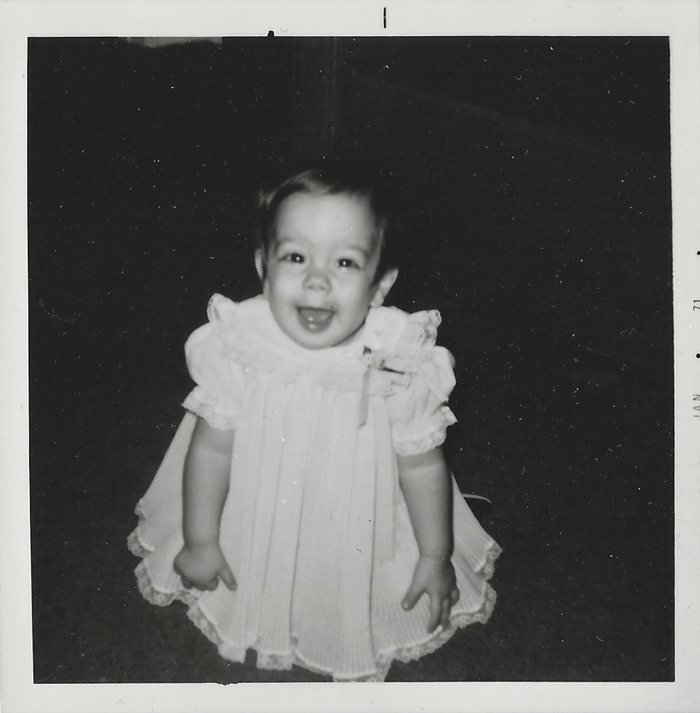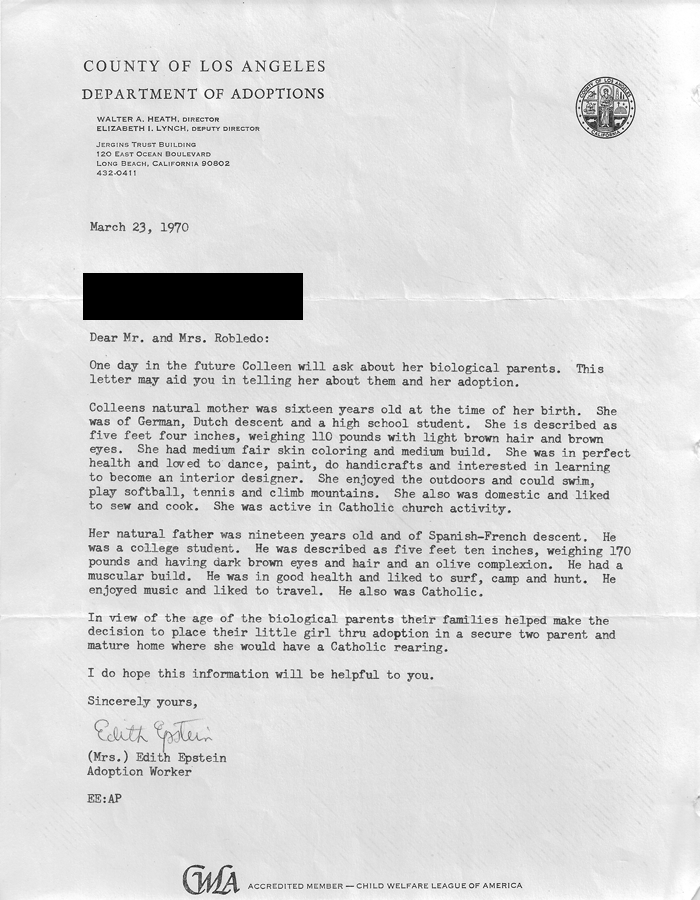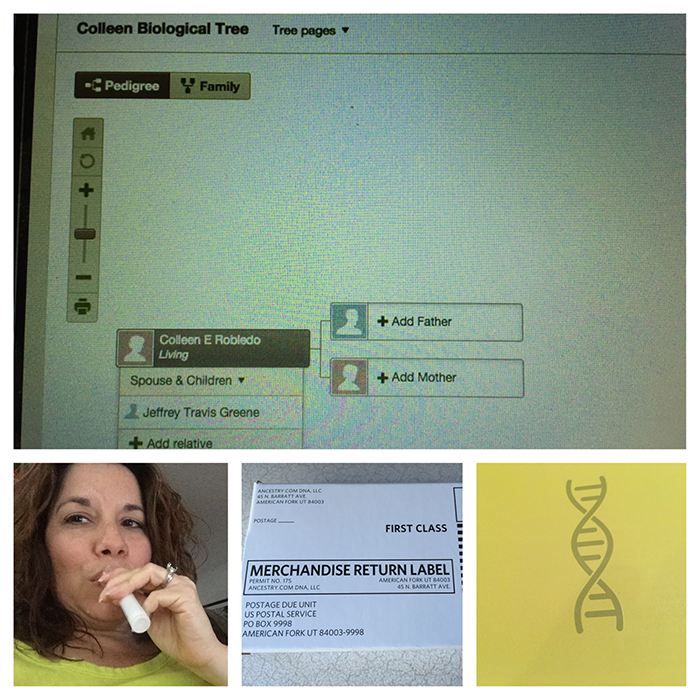
My 12th entry in Amy Johnson Crow’s “52 Ancestors in 52 Weeks” family history blogging challenge for 2015.
The challenge: have one blog post each week devoted to a specific ancestor. It could be a story, a biography, a photograph, an outline of a research problem — anything that focuses on one ancestor.
Amy’s 2015 version of this challenge focuses on a different theme each week.
The theme for week 12 is — Same. What ancestor is a lot like you? What ancestor do you have a lot in common? Same name? Same home town?
My 12th ancestor is my birth mom, with whom I should share half of the same DNA.
I have known my entire life that I was adopted. My parents always told me, and celebrated that fact. My birth announcement reads: “I wasn’t expected, I was selected!” Mom says they would tell me that word long before I could understand its meaning, and then they explained it to me when I was old enough to start understanding. I was put up for adoption at birth, and came home to my parents a few months later, after a very brief stay in a foster home and a hospital incubator due to being born two months premature.
This post is particularly timely, because Monday was the anniversary of the day I came home with my parents. My legal adoption became final six months later.
What I Know About My Birth Parents
My adoption was public, through the County of Los Angeles. I am told I was born at St. Anne’s home for unwed mothers, in Los Angeles, California. In California that means my original birth certificate, with my birth parents’ names, was sealed. All I know about my birth parents is contained within the following letter that was given to my parents when they brought me home on 23 March 1970.
My birth mom was just 16, and my birth father was just 19. They wanted me to be raised in a two-parent married Catholic home, by parents who could better care for me and who of course would love me.
According to the letter, it appears I was predestined to love the outdoors and hiking!
The question I have always wanted an answer to is… if they were 5 feet 4 inches and 5 feet 10 inches tall, how the heck did I end up only 5 feet 1 inch tall??? I should be a few inches taller.

Why Haven’t I Cared to Look?
As I mentioned before, public adoptions in California require that the original birth certificate and records be sealed. An adoptee is allowed to request access to these, once of majority age. Yet even then, a judge has to agree to release identifiable information (birth parent names and details); an adoptee is only guaranteed non-identifiable info.
I am well past majority age, yet I have never bothered with the cumbersome process of requesting my records. Because it just hasn’t ever really mattered to me. I can honestly say that I have no curiosity about my birth parents, no big desire to know their names, and don’t feel any sense of missing identity. I have always felt incredibly loved, and a powerful blood-like bond to my immediate and extended family — including our ancestors. Quite simply, I have the best parents in the world. I am the poster child for how adoption is supposed to work.
What is Different Now?
While I still confidently say that I don’t care if I ever find out the identities of my birth parents, something has changed. What has changed is a growing sense of compassion for what my birth mother went through 45 years ago. I attribute it to just getting older, having helped raise a child (my oldest niece), and becoming a wife and stepmom five and a half years ago. Because these feelings never really crossed my mind until a handful of years ago.
I have come to recognize and respect that putting me up for adoption was probably the most difficult decision my birth mother ever made. It was an incredibly brave selfless act. Every December 20th on my birthday, I imagine that my birth mom is thinking about the baby girl she gave up, wondering if she did the right thing, if her baby was safe, if her baby was loved. I can’t imagine carrying a child and nurturing it in the womb, and then having the emotional strength to give that baby up to others. Having grown up to a point where I can truly appreciate that sacrifice, I would like to be able to assure her that her baby was and is loved as much as is humanly possible. I was blessed with the very best parents and family possible.
And then there’s that whole genetic genealogy thing…
Until very recently, I have not jumped on the genealogy DNA craze. Mostly because my family history is not in my DNA. But early last year, I caved and tested Dad through AncestryDNA in the hopes of breaking through my Robledo surname brick wall. But at RootsTech and FGS last month, I learned about how DNA was being used by adoptees to find birth families. That caught my curiosity. I have always loved solving puzzles. This sounded fun, like a great learning opportunity, and like a great case study to put under my research skills belt. Getting introduced to and hooked on new friend Michael Lacopo’s Hoosier Daddy? blog intensified this interest.
So last week, I took an autosomal test from AncestryDNA. And started a biological family tree.
My Next Steps
Aside from impatiently waiting over the next 4 to 8 weeks for AncestryDNA to process my autosomal DNA results, which I will of course also upload to Family Tree DNA and GEDmatch, I have some next plans of action already in place.

- I joined the DNA Detectives group on Facebook last week.
- I just enrolled in the May 8th session of the Working with Autosomal DNA online course by DNA Adoption.
- I plan to enlist the services of my new DNA consultant friend Angie Bush, a brilliant molecular genealogist, to teach me what to do with this data, and how to calculate relationships of those who share my DNA.
- I am attending DNA Day at the Southern California Genealogy Jamboree in June, especially CeCe Moore’s DNA and adoptees session.
- Being the kick-butt librarian that I am, I will continue researching everything I can about genetic genealogy and how to analyze the DNA results.
- I guess I need to also finally fill out and send in the notarized forms asking the County of Los Angeles to open and release my adoption file. Paper records still count!
My mom, who works in adoptions, has always been very supportive of me tracking down my birth family (so has Dad). But as Moms always do, she continues to try to protect me and shield me from disappointment. Mom has gently warned me that I need to be prepared to accept that my birth parents might not want to be found. She encounters this regularly in her work. Both biological parents have most likely gone on with their lives, marrying others and possibly having more children. They might not have told their new spouses and children about this incident from their past. They might not want them to know. They might not want to be found.
If so, that’s okay too. Like I said, finding them has never been important to me. It won’t hurt me. And having taken Judy Russell’s Ethical Genealogist session at FGS, I understand that while it is my right to know, it is not my right to force others to know, or to blow someone else’s secret.
At the very least, this remains a great learning opportunity and case study for my portfolio. Perhaps it will equip me to help give back to the adoption community by being able to assist others seeking to venture into this same journey.
Wishing you all the best wherever this may lead you. Enjoyed reading about the beginning of your DNA journey.
Thanks, Cathy!
Hi, Colleen! I featured your post on this week’s 52 Ancestors recap: http://www.nostorytoosmall.com/posts/52-ancestors-challenge-2015-week-12-recap/ Sending many good thoughts your way.
Amy
Thanks again, Amy! Ironically, I’m not sure I would have started the process when I did if it weren’t for your “Same” prompt!
I wish you luck in your journey. 🙂
Thanks, Tina! The journey alone will be worth the effort. Even if I don’t get answers, or a welcome reception.
What a lovely tribute to your parents.
Thanks, Shea! They deserve the tribute!
Unless you try, you’ll never know, and you don’t want to leave this earth without giving it your best shot. Don’t let the unknown hold you back. The worse scenario – they don’t want to be found for whatever reason. At least then you will know. On the flip side, maybe they open their arms and you share a hug. Then there is always the possibility they have passed on.Then it will be out of your hands as to how they would have received you, although it will probably leave you with more difficult questions, like half-brothers and/or sisters. What to do? Follow your heart, deeply believe in what you feel, and you can’t go wrong. One thing I guarantee you is that there is not a day that passes when your birth mother hasn’t given you a thought or a prayer. That IS just how it is when you grow a child and share your body. They made a difficult, wise decision long ago as you are doing today.
I wish you the best on your journey and peace with all that you discover.
Christine
Where are you from?
Oh, Colleen, I hope someday, your birth mother reads this and understands that you understand…
Thanks, Jacqui. And it was nice to meet you in person at Jamboree!
Thanks for contributing. I’m interested to follow your emotional story since it has been almost a year. Did you write a followup?
I too was born at St. Anne’s. Did you finally find your DNA people? I finally found my birth parents in 1995 and have to tell you it was worth all the effort. I just finished reading American Baby (2021) by Gabrielle Glaser — a real eye-opener. If you want to talk about all this, let me know.